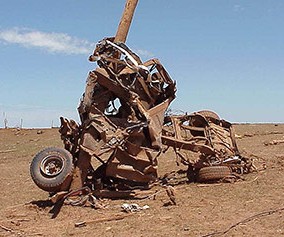by Brianna Crandall — December 28, 2015—Protecting schools and their associated high-occupancy buildings from the most violent tornadoes is the goal of the first approved building code changes based on recommendations from the National Institute of Standards and Technology (NIST) technical investigation into the impacts of the deadly tornado that struck Joplin, Missouri, on May 22, 2011.
The new changes, approved at a recent meeting of the International Code Council (ICC), apply to the nation’s most tornado-prone regions. Enhanced protection will be required for new school buildings and additions to buildings on existing school campuses, as well as facilities associated with schools where people regularly assemble, such as gymnasiums, theaters and community centers.

The power of an EF-5 tornado is evident in this photo of a truck wrapped around a utility pole in the aftermath of a May 1999 twister in Oklahoma with 300 mph winds. Credit: National Severe Storms Laboratory, NOAA
Under the updated codes, storm shelters must be provided that protect all occupants from storms with wind speeds of 400 kilometers per hour (250 miles per hour), representing the maximum intensity category EF-5 on the Enhanced Fujita Scale. The area covered by the upgraded codes stretches from northern Texas to central Minnesota, and from western Oklahoma to western Pennsylvania. It includes the notorious “Tornado Alley” and “Dixie Alley” regions of the midwestern and southern United States, respectively.
The improved storm shelter requirements will be published in ICC’s 2018 International Building Code (IBC) and 2018 International Existing Building Code (IEBC). These are the state-of-the-art model codes used as the basis for building and fire regulations promulgated and enforced by U.S. state and local jurisdictions.
Based on findings from its Joplin study, NIST developed 16 recommendations for improving how buildings and shelters are designed, constructed and maintained in tornado-prone regions, along with improving the emergency communications that warn of imminent threat from tornadoes.
According to Marc Levitan, leader of the NIST team that conducted the Joplin investigation, the new changes to the IBC and IEBC mark the first milestone of the collaborative effort to implement these recommendations, and solid progress is being made working with code developers, state and local officials, U.S. agencies and others toward realizing all of the proposed improvements for tornado protection and resilience in the study.
According to Levitan, current efforts include developing:
- More detailed and accurate tornado hazard maps for the United States (to support standards on performance-based, tornado-resilient building designs);
- An improved Fujita scale based on advanced techniques for wind speed estimation;
- Draft standards for better selecting buildings to serve as disaster shelters; and
- Guidelines for determining the best available tornado refuge areas in existing buildings.
NIST’s Joplin investigation team members also recently provided their expertise and insight to help FEMA improve guidance on public sheltering strategies and practices in its publication, FEMA P-361, Safe Rooms for Tornadoes and Hurricanes: Guidance for Community and Residential Safe Rooms, Third Edition (2015).
Levitan and his colleagues will continue to work with their partners to realize the main goal of the Joplin investigation: nationally accepted standards for building design and construction, public shelters and emergency communications that can significantly reduce deaths and the steep economic costs of property damage caused by tornadoes.





